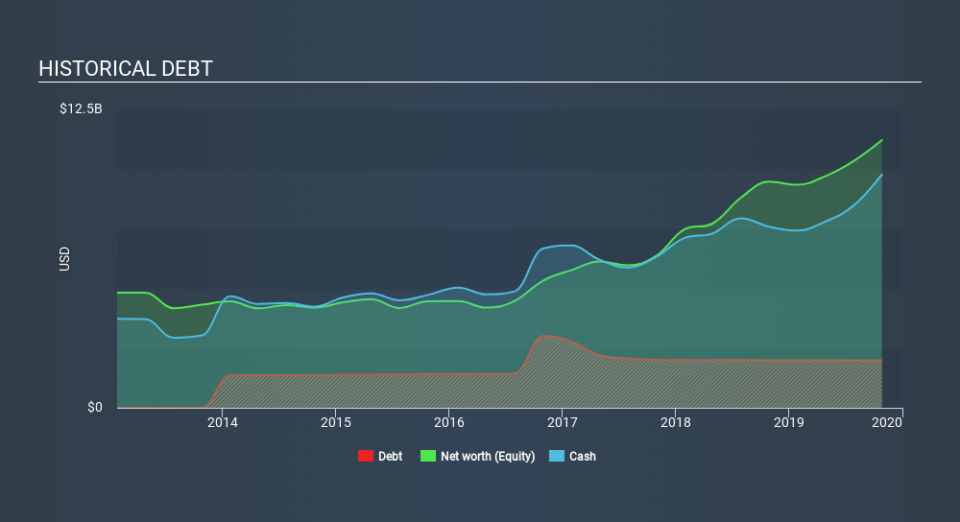We Think NVIDIA (NASDAQ:NVDA) Can Stay On Top Of Its Debt

Warren Buffett famously said, 'Volatility is far from synonymous with risk.' When we think about how risky a company is, we always like to look at its use of debt, since debt overload can lead to ruin. We note that NVIDIA Corporation (NASDAQ:NVDA) does have debt on its balance sheet. But should shareholders be worried about its use of debt?
When Is Debt Dangerous?
Debt assists a business until the business has trouble paying it off, either with new capital or with free cash flow. Part and parcel of capitalism is the process of 'creative destruction' where failed businesses are mercilessly liquidated by their bankers. However, a more usual (but still expensive) situation is where a company must dilute shareholders at a cheap share price simply to get debt under control. Of course, debt can be an important tool in businesses, particularly capital heavy businesses. The first thing to do when considering how much debt a business uses is to look at its cash and debt together.
View our latest analysis for NVIDIA
What Is NVIDIA's Debt?
You can click the graphic below for the historical numbers, but it shows that as of October 2019 NVIDIA had US$1.99b of debt, an increase on US$2.0k, over one year. However, its balance sheet shows it holds US$9.77b in cash, so it actually has US$7.78b net cash.
How Healthy Is NVIDIA's Balance Sheet?
We can see from the most recent balance sheet that NVIDIA had liabilities of US$1.48b falling due within a year, and liabilities of US$3.12b due beyond that. Offsetting this, it had US$9.77b in cash and US$1.46b in receivables that were due within 12 months. So it actually has US$6.63b more liquid assets than total liabilities.
This surplus suggests that NVIDIA has a conservative balance sheet, and could probably eliminate its debt without much difficulty. Simply put, the fact that NVIDIA has more cash than debt is arguably a good indication that it can manage its debt safely.
The modesty of its debt load may become crucial for NVIDIA if management cannot prevent a repeat of the 53% cut to EBIT over the last year. When it comes to paying off debt, falling earnings are no more useful than sugary sodas are for your health. When analysing debt levels, the balance sheet is the obvious place to start. But ultimately the future profitability of the business will decide if NVIDIA can strengthen its balance sheet over time. So if you're focused on the future you can check out this free report showing analyst profit forecasts.
Finally, a company can only pay off debt with cold hard cash, not accounting profits. NVIDIA may have net cash on the balance sheet, but it is still interesting to look at how well the business converts its earnings before interest and tax (EBIT) to free cash flow, because that will influence both its need for, and its capacity to manage debt. Happily for any shareholders, NVIDIA actually produced more free cash flow than EBIT over the last three years. That sort of strong cash conversion gets us as excited as the crowd when the beat drops at a Daft Punk concert.
Summing up
While we empathize with investors who find debt concerning, you should keep in mind that NVIDIA has net cash of US$7.78b, as well as more liquid assets than liabilities. And it impressed us with free cash flow of US$3.6b, being 101% of its EBIT. So we don't have any problem with NVIDIA's use of debt. There's no doubt that we learn most about debt from the balance sheet. However, not all investment risk resides within the balance sheet - far from it. For instance, we've identified 2 warning signs for NVIDIA that you should be aware of.
If you're interested in investing in businesses that can grow profits without the burden of debt, then check out this free list of growing businesses that have net cash on the balance sheet.
If you spot an error that warrants correction, please contact the editor at editorial-team@simplywallst.com. This article by Simply Wall St is general in nature. It does not constitute a recommendation to buy or sell any stock, and does not take account of your objectives, or your financial situation. Simply Wall St has no position in the stocks mentioned.
We aim to bring you long-term focused research analysis driven by fundamental data. Note that our analysis may not factor in the latest price-sensitive company announcements or qualitative material. Thank you for reading.

 Yahoo Finance
Yahoo Finance 
